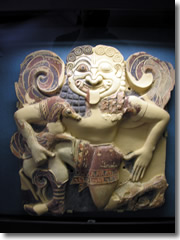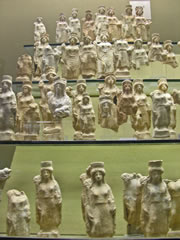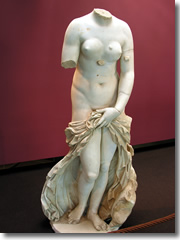- Places
- Plans
- Itineraries
- Experiences

Dwarf elephant skeletons elephas (palaeoloxodon) falconeri busk.

The 6th century BC Gorgon relief.This fantastic museum is one of Italy's top archaeological collections, and by far the best in Sicily.
It'd be a worthwhile stop simply for the aesthetic beauty of many pieces, and the well-documented exhibits make it invaluable for understanding the Greek and other cultures of ancient Sicily.
Section A takes care of the island's southeastern corner during prehistoric times, kicking off with a pair of articulated dwarf elephant skeletons found in nearby caves (pictured at the top of the page).
Looking at the skulls it's easy to see why many academics believe that their odd shape and large central nasal passage led the local ancients—who surely stumbled across them—to invent the myth of one-eyed, cave-dwelling giants called Cyclopes.
But the best part of the prehistoric section is the remains left by humans, a collection of tools, ceramics, and sculptures that open a window onto the richness of Stone and Bronze Age cultures.

5th century BC votive statuettes dedicated to Demeter/Ceres and Kore/Persephone Section B covers Siracusa and its province in all its ancient Greek glory. The highlights include:
Section C contains the best remains from Magna Graecia settlements across eastern Sicily, including decorated vases from Gela spanning the 6th and 5th centuries BC; an enthroned goddess from 6th-century BC Grammichele; and a trio of rare 7th-century BC wooden statues found near Agrigento.

The Venus Landolina.Opened in 2006 in a new area upstairs, Settore D houses remains from Sicily's Roman and Hellenistic eras of the 4th and 5th centuries AD.
This section is the new home of some of the museum's set pieces, including the headless Venus Landolina, an Imperial Roman copy of a 2nd-century BC statue that's a lesson in both anatomy and aesthetics, and the spectacularly carved 4th-century Sarcofago di Adelfia sarcophagus from the San Giovanni catacombs.
There's also a collection of ancient coins up here, though it only stays open until 1:30pm (until 5:30pm Wednesdays).
★★ Museo Archeologico Paolo Orsi
Viale Teocrito 66
tel. +39-0931-489-511 or 0931-464-022
www.regione.sicilia.it/beniculturali
Open Tues–Sat 9am–6pm, Sun 9am–2pm
Adm: €8
Bus there: 1, 4, 5, 8, 26
Bus
back: 2, 3, 18, 25
Give this museum at least an hour. Archaeology aficionados might stick around for two hours or more.
Because Siracusa buses follow circular routes (rather than out and back), you have to take one bus there (well, one of several choices), but a different bus back.
The bus depot on Ortigia is at Riva Nazario Sauro on the northeast corner of the island:
Share this page
Search ReidsItaly.com
★★ Museo Archeologico Paolo Orsi
Viale Teocrito 66
tel. +39-0931-489-511 or 0931-464-022
www.regione.sicilia.it/beniculturali
Open Tues–Sat 9am–6pm, Sun 9am–2pm
Adm: €8
Bus there: 1, 4, 5, 8, 26
Bus
back: 2, 3, 18, 25